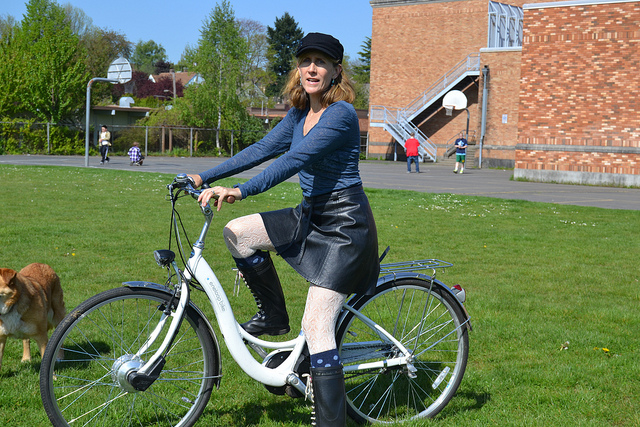Send your question to Umbra!
Q. Dear Umbra,
When I got my bike a year ago, I had high hopes that I would use it all the time in place of my car. But where I live, it’s just too hard to go anywhere with a load of groceries — I have a hard enough time lugging myself around. And it’s just not a bike-friendly town. I’ve found compatriots, but they all bike for fun or exercise. I want to use my car less, I want to use a bike more, so … I’m thinking of getting a motorized bicycle. Is that OK, even though it feels like cheating? Do you have any recommendations for one under $1,000?
V.
Rockford, Ill.
A. Dearest V.,
Purists might scoff, but I say yes, it is OK for you to buy a motorized bicycle, fondly known as an e-bike. I applaud your effort to de-car your life — we should all drive as little as possible, whenever possible, within the parameters of our daily reality.
For the uninitiated: E-bikes are basically regular bicycles endowed with a small, battery-powered motor. They can cruise along at speeds of up to 20 mph, and the charge will last roughly 20 miles, depending on battery type, riding conditions, and so forth. In most cases, you still pedal a bit, although some e-bikes do all the work. The amount of pedaling you do will vary according to the type of bike, the settings it offers, and how eager you are to get up that monster hill.
Interestingly, in terms of eco-impacts, e-bikes compare relatively well to walking and standard bicycling. Yes, they take more energy and materials to produce and operate (most recharge by being plugged into a standard socket, though there are some solar models). But according to several lifecycle analyses I’ve peeked at, e-bikes rank well. At MIT, for instance, Shreya Dave compared [PDF] several modes of transit, and found that walking, bicycling, and electric bicycling ultimately released the same amount of greenhouse gas emissions. She concluded that “all forms of [individual] transport are at least three times better than any other form of commuter transport.” In other words: Bikes rule!
For this and other reasons, The Experts are placing high hopes on e-bikes as a weapon against climate change, especially in heavily congested cities in China (where 30 million e-bikes were sold last year), India (1.4 million), and Europe (400,000). The machines have been slower to catch on in America, but we bought 80,000 of them last year — honestly, I’d have guessed closer to 80 — and some say aging Boomers, whose love of bikes is too often thwarted by bum knees, will push sales higher.
So V., you could be part of a trend. But I’m afraid your $1,000 cap will severely limit your choices, as most e-bikes start at about $1,500. While I am not in the business of recommending products, I do note that a few models are available closer to the $500 range (and are sold at, among other places, Walmart). But do your research and read reviews. You might also want to look into an “e-bike conversion kit,” generally $300-$500, which will give your current bike a boost. I hope you’ll also check out cargo bikes (or attachments), which allow you to lug groceries, kids, and what-have-you around town a little more easily, and come in both electric and standard versions.
One last thought before I coast away from this topic: What if your bicycle-unfriendly town is still bicycle-unfriendly to your newfangled bicycle? An easier ride for you doesn’t lead to the magical appearance of bike lanes, downtown parking, understanding officials, and the other components it takes to make a town truly bike-friendly. So if you have any energy left, take a look at these tips for making your town more bike-friendly. Before you know it, you’ll turn Rockford into Rollford!
Oh yes I did-ly,
Umbra




